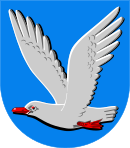Laridae
| Laridae | |
|---|---|

| |
| European herring gull | |
| Scientific classification | |
| Domain: | Eukaryota |
| Kingdom: | Animalia |
| Phylum: | Chordata |
| Class: | Aves |
| Order: | Charadriiformes |
| Suborder: | Lari |
| Family: | Laridae Rafinesque, 1815 |
| Genera | |
|
See text. | |
Laridae is a
Taxonomy

| Laridae phylogeny | |||||||||||||||||||||||||||||||||||||||||||||||||||||||||
| |||||||||||||||||||||||||||||||||||||||||||||||||||||||||
| Part of the cladogram of the genera in the order Charadriiformes based on the analysis by Baker and colleagues published in 2007.[1] |
The family Laridae was introduced (as Laridia) by the French
A
Baker and colleagues found that the Laridae lineage diverged from a lineage that gave rise to both the skuas (
Anders Ödeen and colleagues investigated the development of ultraviolet vision in shorebirds, by looking for the SWS1 opsin gene in various species; as gulls were the only shorebirds known to have developed the trait. They discovered that the gene was present in the gull, skimmer, and noddy lineages but not the tern lineage. They also recovered the noddies as an early lineage, though the evidence was not strong.[9]
Genera
For the complete list of species, see the article
Noddies[a]
- Genus Anous (5 species)
- Genus Gygis (white tern)[b]
Skimmers
- Genus Rynchops (3 species)
Gulls
- Genus Creagrus (swallow-tailed gull)
- Genus Rissa (kittiwakes) (2 species)
- Genus Pagophila (ivory gull)
- Genus Xema (Sabine's gull)
- Genus Chroicocephalus (11 species)
- Genus Hydrocoloeus (little gull)
- Genus Rhodostethia (Ross's gull)
- Genus Leucophaeus (5 species)
- Genus Ichthyaetus (6 species)
- Genus Larus (25 species)
Terns
- Genus Gelochelidon (2 species)
- Genus Hydroprogne (Caspian tern)
- Genus Thalasseus (8 species)
- Genus Sternula (7 species)
- Genus Onychoprion (4 species)
- Genus Sterna (13 species)
- Genus Chlidonias(4 species)
- Genus Phaetusa (large-billed tern)
- Genus Larosterna (Inca tern)
Distribution and habitat

The Laridae have spread around the world, and their adaptability has likely been a factor. Most have become much more aerial than their ancestor, which was likely some form of shorebird.[10]
Notes
- ^ The genera are listed in taxonomic order.[6]
- ^ There is discussion in the IOC about renaming this species "white noddy" to reflect its relationships
References
- ^ .
- ^ Rafinesque, Constantine Samuel (1815). Analyse de la nature ou, Tableau de l'univers et des corps organisés (in French). Vol. 1815. Palermo: Self-published. p. 72.
- hdl:2246/830.
- ISBN 978-0-643-06511-6.
- Ahlquist, Jon Edward(1990): Phylogeny and classification of birds. Yale University Press, New Haven, Conn.
- ^ a b Gill, Frank; Donsker, David, eds. (2019). "Noddies, gulls, terns, auks". World Bird List Version 9.2. International Ornithologists' Union. Retrieved 23 June 2019.
- S2CID 216448411. Retrieved 22 April 2017.
- .
- PMID 20015861.
- ^ Moynihan, Martin (1959). A revision of the family Laridae (Aves) (PDF). American Museum Novitates. Vol. 1928. New York: American Museum of Natural History.
Further reading
- Grant, Peter J. (1986) Gulls: a guide to identification ISBN 0-85661-044-5
- Howell, Steve N. G. and Jon Dunn (2007) Gulls of the Americas ISBN 0-618-72641-1
- Olsen, Klaus Malling & Larsson, Hans (1995): Terns of Europe and North America. ISBN 0-7136-4056-1
